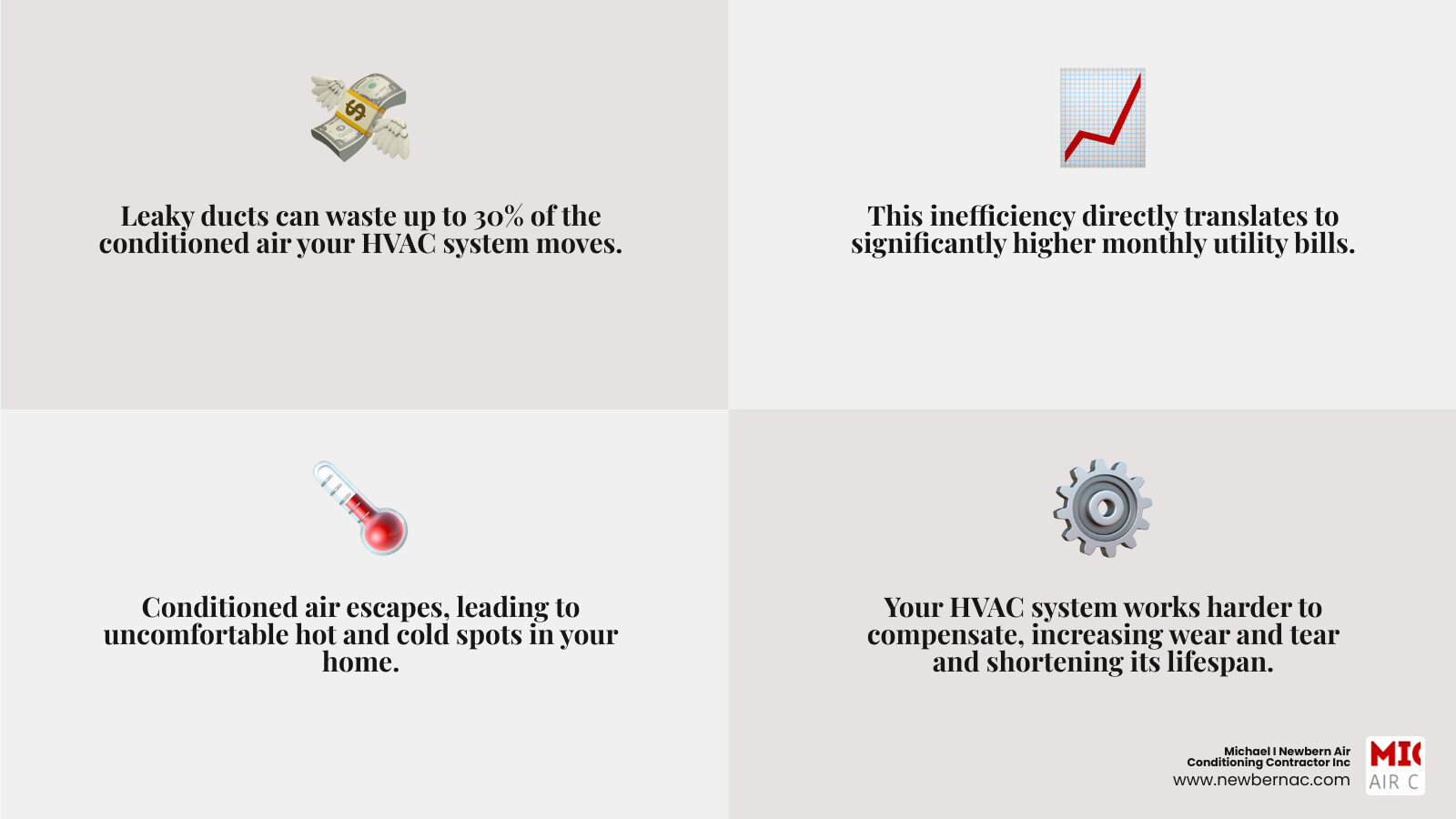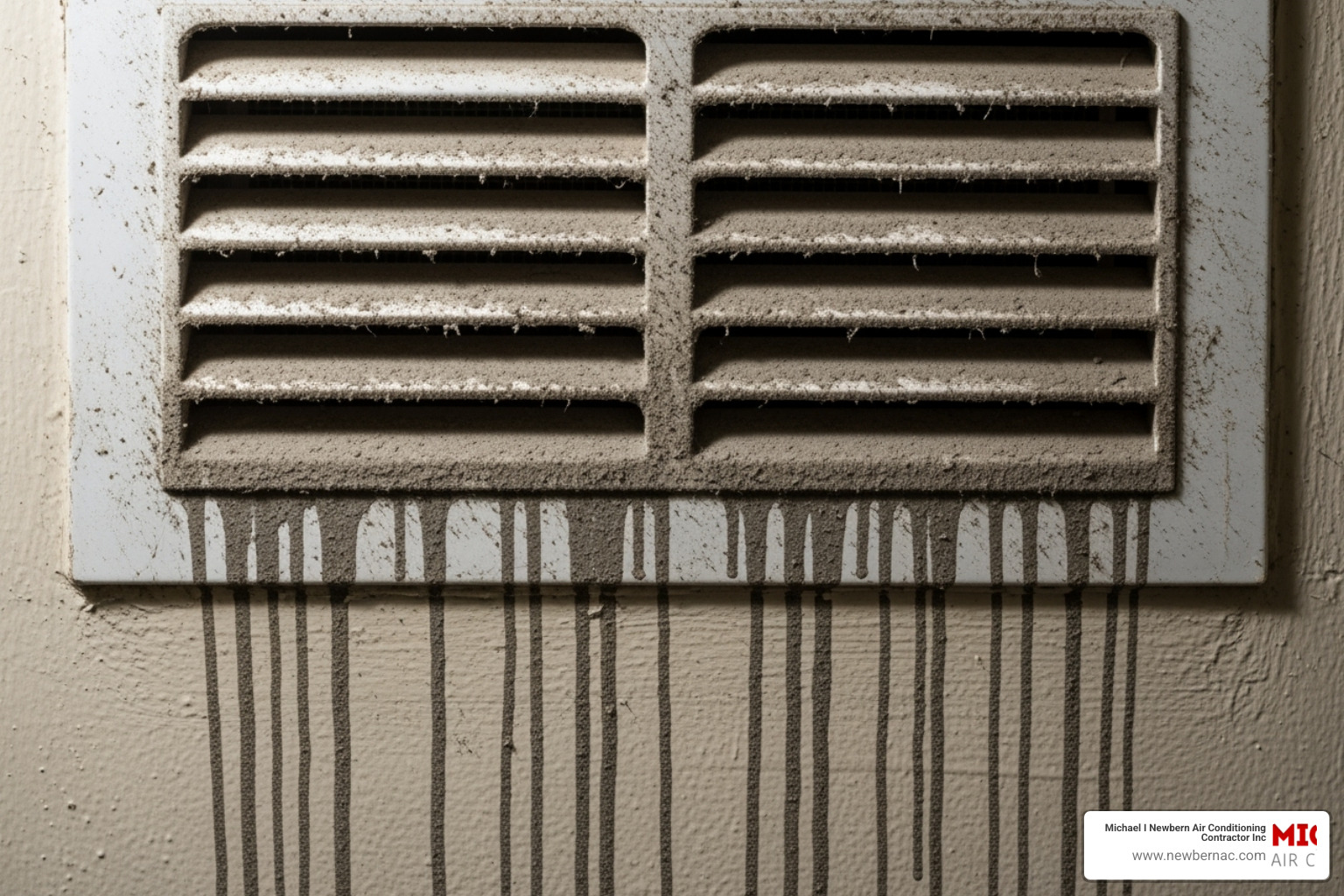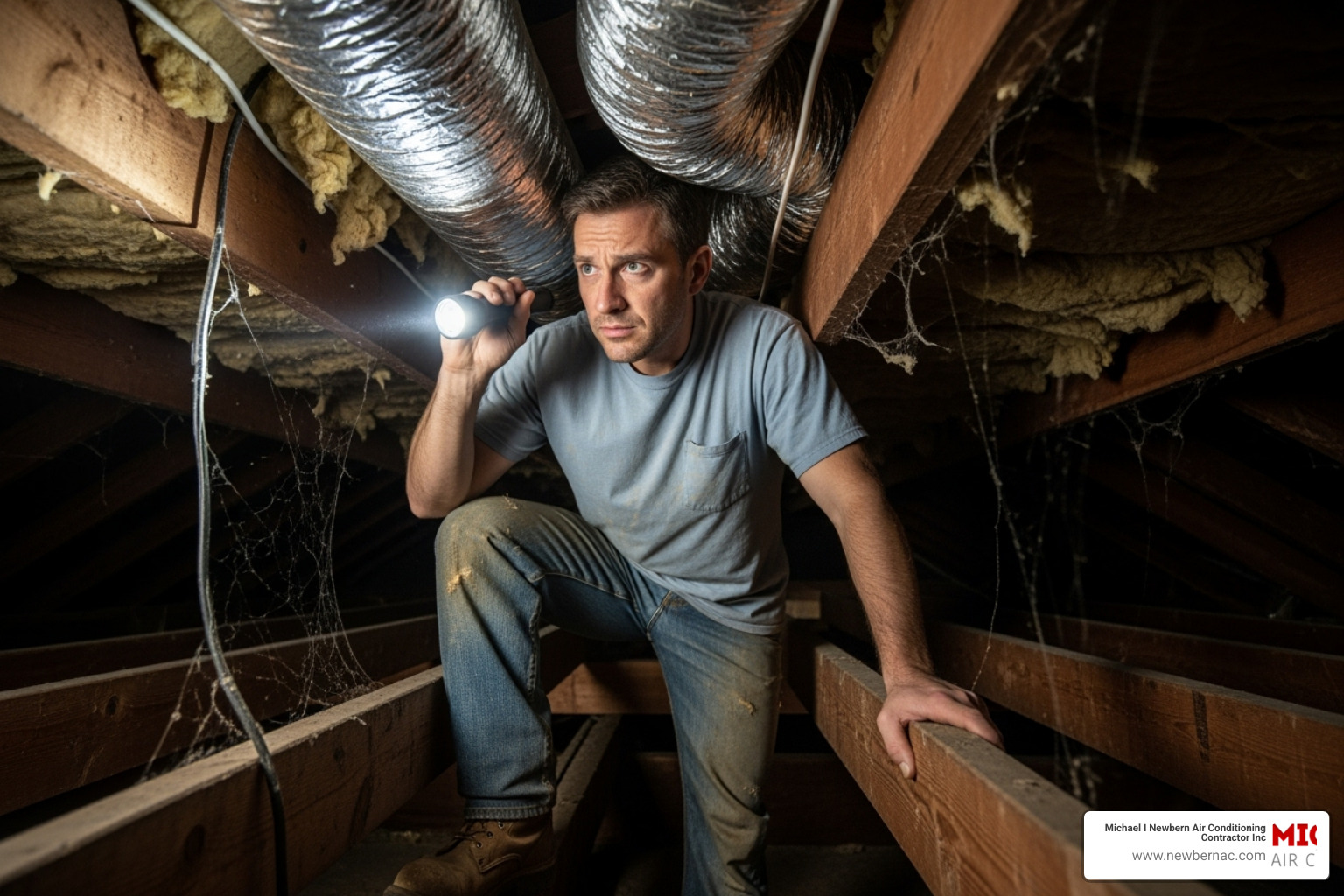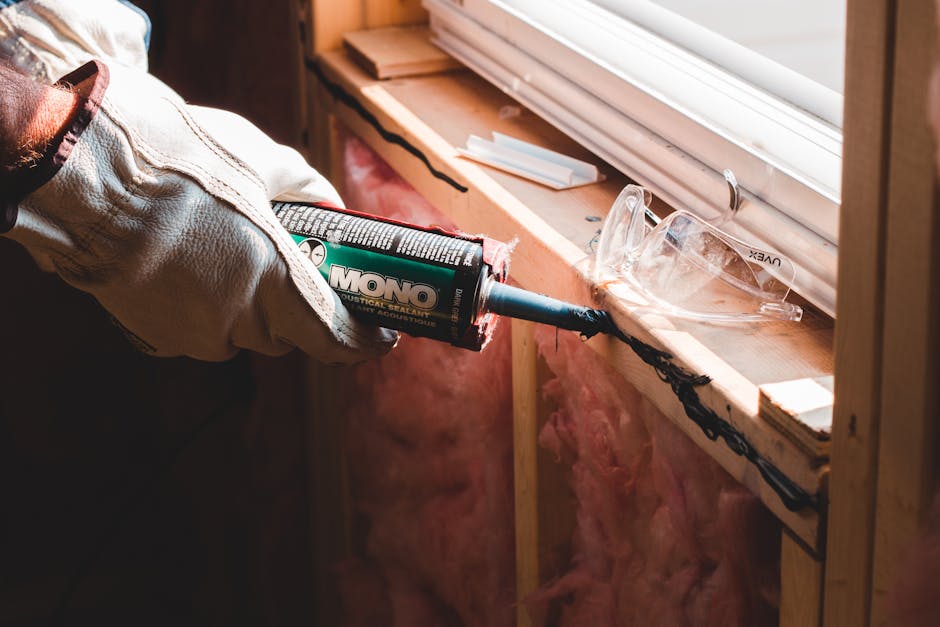Why Your Home’s Air Ducts Matter More Than You Think
Air duct repair is essential for your HVAC system’s efficiency and home comfort. When ductwork develops leaks or cracks, it forces your AC system to work harder while delivering less cooling.
Quick Assessment for Air Duct Problems:
- Uneven temperatures between rooms
- Higher energy bills without increased usage
- Poor airflow from vents
- Dusty surfaces near air registers
- Strange noises like hissing or whistling from ducts
- Musty odors when the system runs
Think of your ductwork as your HVAC system’s circulatory system. Damaged ducts prevent your air conditioner from effectively delivering conditioned air throughout your home.
The impact is significant. Leaky ducts can waste up to 30% of the air your HVAC system moves, according to industry studies. That means nearly one-third of your energy bill is wasted.
In Central Florida’s climate, this inefficiency means higher utility bills, inconsistent comfort, and unnecessary strain on your equipment. This guide will help you decide between repair and replacement.
Signs Your Ductwork Needs Attention
Your home’s ductwork is often out of sight, but ignoring it can lead to serious comfort and budget headaches. With over 30 years of experience serving Central Florida families from Auburndale to Haines City and Davenport, we know the warning signs.
Your home provides warning signs when ducts need attention. Uneven temperatures are a primary clue. If one room is always too hot or cold, leaky ducts are likely the culprit, allowing conditioned air to escape into your attic or crawl space.
High utility bills without increased usage also point to leaky ducts. Losing up to 30% of your conditioned air means you’re paying to cool your attic. Your HVAC system works harder, driving up energy bills.
Poor airflow from vents is another telltale sign. Weak or inconsistent airflow means air is escaping somewhere along the path, leaving your rooms uncomfortable.
Strange whistling or hissing sounds from walls or ceilings indicate air escaping through cracks in your ductwork. Our guide on fixing whistling or hissing AC sounds can help.
Musty or moldy odors when your system runs can signal a serious problem. Leaky ducts can pull in humid air, creating conditions for mold growth that affect your air quality and health.
Finally, visible pest activity near vents suggests compromised ducts. Pests can chew through duct materials, creating leaks and introducing contaminants.
Common Causes of Leaky Air Ducts
Understanding why ducts fail helps prevent future problems and informs air duct repair decisions. Poor initial installation is common; gaps or loose connections worsen over time.
Age and corrosion take their toll. Well-maintained ductwork can last 20-25 years, but seals and joints start breaking down around the 15-year mark. Metal ducts are prone to rust in Florida’s humid climate.
Physical damage can occur from home renovations or accidentally stepping on ducts. Rodent or insect damage creates similar problems when critters chew through materials.
Separated joints and seams are a common culprit. Over time, sealing materials like old tape or dried-out mastic fail, creating significant gaps where conditioned air escapes.
How to Inspect Your Ducts
While a professional inspection is best, you can check for obvious problems yourself.
Start with a visual inspection for tears or holes in accessible ductwork. Check attics or crawl spaces for tears, holes, or crushed sections, focusing on seams and connections.
Feeling for air leaks is surprisingly effective. With your HVAC system running, run your hand along accessible duct seams. You can often feel air escaping from larger leaks.
The smoke pencil test is a more advanced DIY method. Hold an incense stick or smoke pencil near duct joints while your system runs. If the smoke is disturbed, you’ve found a leak.
The National Air Duct Cleaners Association (NADCA) recommends regular inspections every 5-10 years. Professionals use advanced tools to find hidden leaks and assess the overall condition, even in hard-to-reach places.
Professional Air Duct Repair vs. DIY Fixes
When you find ductwork problems, you must decide: DIY or call a professional? The answer depends on several factors.
The scope of damage is the first consideration. A tiny, accessible pinhole leak might be a DIY project. Multiple leaks, crushed sections, or widespread damage require a professional.
Accessibility is another crucial factor. If ducts are in a cramped crawl space or behind walls, a DIY repair can be difficult and dangerous.
Proper air duct repair requires tools beyond a typical toolbox, like pressure testing equipment and professional-grade sealants. Professionals also have the necessary safety gear for confined spaces.
Long-term effectiveness is a key difference. Professional repairs using industry-standard materials last for years. DIY fixes, especially with the wrong materials like standard duct tape, are often temporary.
Safety considerations can’t be overlooked. Working in hot attics or tight crawl spaces presents risks, including potential contact with electrical wiring, sharp metal, or asbestos in older homes.
DIY Methods for Minor Air Duct Repair
For small, accessible leaks, some DIY approaches are effective. This applies only to minor issues.
Mastic sealant is your best friend for DIY duct sealing. This paste-like substance creates a hard, airtight seal. Apply it with a caulk gun or paintbrush. For gaps larger than a quarter-inch, reinforce the mastic with fiberglass mesh tape.
Foil-backed tape is another solid option, but be sure to use UL 181-rated tape designed for HVAC use. Clean the surface, press the tape firmly, and overlap the edges for a good seal.
To seal small, accessible holes, clean and dry the area, then apply your chosen sealant. Use foil-backed tape for pinholes and mastic sealant for larger holes.
Insulating ducts in unconditioned spaces like attics or crawl spaces is crucial for preventing energy loss. The Department of Energy advises sealing leaks first. Use metal tape or mastic sealer to seal affected areas before insulating.
Essential DIY duct sealing supplies include UL 181-rated foil-backed tape, mastic sealant, fiberglass mesh tape, a putty knife or paintbrush, clean rags, a utility knife, a flashlight, and safety gear like gloves and glasses.
When to Call a Professional
While DIY is admirable, some situations require professional expertise. Poor repairs can end up costing more.
Extensive or widespread damage requires professional help. Multiple leaks, large tears, or system-wide deterioration may require replacing sections, which is not a DIY job.
Inaccessible ductwork presents challenges that professionals are equipped to handle safely with specialized tools.
Signs of mold growth require immediate professional attention. Attempting to clean mold yourself can spread spores throughout your home. We can safely remediate mold and address its cause.
A significant drop in HVAC performance indicates problems beyond simple repairs. If energy bills have jumped or your home is uncomfortable, you likely have major ductwork issues needing professional diagnosis. These symptoms can overlap with other issues, as discussed in our guide on 5 Signs Your AC Unit Needs Repair.
The Big Decision: Repair or Replace Your Ductwork?
Once you know your ductwork has issues, you face a big decision: repair or replace? With over 30 years of experience helping homeowners in Auburndale, Haines City, and Davenport, we know this choice isn’t always straightforward.
Ductwork typically lasts 15-25 years with proper maintenance. However, lifespan varies based on several key factors.
Duct material plays a huge role. Sheet metal ducts tend to be more durable than flexible ducts, but even sturdy materials can fail if installed incorrectly.
Installation quality is critical. A properly installed system can last for decades, while poor workmanship leads to early problems. In Central Florida’s climate, ducts in attics face extreme temperatures and humidity, accelerating wear on subpar installations.
Your home’s maintenance history also matters. Regular inspections and prompt air duct repair can significantly extend your system’s life.
If you’re considering HVAC system upgrades, it’s a good time to evaluate your ducts. Our guide on Should You Repair or Replace Your Air Conditioner? can help. When investing in a new, high-efficiency HVAC system, it’s wise to ensure the ductwork is compatible.
Key Factors for Your Decision
Here’s how we help homeowners think through the repair versus replacement question:
| Scenario for Repair | Scenario for Replacement |
|---|---|
| Age of Ductwork: Less than 15 years old | Age of Ductwork: 15-25 years old or more |
| Extent of Damage: Minor, isolated leaks or small tears in accessible areas | Extent of Damage: Widespread leaks, crushed sections, significant deterioration |
| Presence of Mold: No mold, or very localized and easily remediated | Presence of Mold: Extensive mold growth throughout the system |
| Compatibility with New HVAC: Current ductwork is appropriately sized and compatible with existing or planned HVAC system | Compatibility with New HVAC: Ductwork is old, undersized, or incompatible with a new, high-efficiency HVAC system |
| Overall Condition: Generally good, stable, and well-maintained | Overall Condition: Deteriorated, brittle, or showing signs of long-term neglect |
| Energy Loss: Minor air leakage, easily sealed | Energy Loss: Significant energy loss (e.g., 20-30% of conditioned air) |
Age matters. For ductwork under 15 years old with isolated problems, repair is usually best. For ducts over 20 years old with multiple issues, replacement often provides better long-term value.
The extent of damage is often the deciding factor. We can seal minor leaks and tears. However, patching crushed sections or widespread corrosion is futile.
Mold presence is a serious consideration. We can clean minor mold, but extensive growth means ducts have been compromised by moisture. Replacement is necessary to protect your family’s health and prevent recurrence.
Compatibility with modern HVAC systems is increasingly important. Today’s high-efficiency units require properly sized, sealed ductwork. Undersized or poorly designed ducts can reduce a new system’s efficiency by 20-30%.
Your long-term plans also factor in. If you plan to stay in your home, new ductwork provides long-term comfort and savings. A well-functioning duct system is also a strong selling point if you plan to sell.
We provide honest assessments, whether that means a simple air duct repair or a full replacement. Our goal is to help you make the best choice for your family.
Benefits of a Well-Sealed Duct System
Investing in professional air duct repair or replacement offers numerous benefits that transform your home’s comfort and performance. With over 30 years serving Central Florida families from Auburndale to Davenport, we’ve seen the remarkable difference sealed ductwork makes.
Improved HVAC efficiency is an immediate change. When ducts are sealed, all conditioned air reaches its destination. Your air conditioner runs more smoothly and efficiently, no longer working overtime to compensate for escaped air.
This efficiency boost leads directly to lower energy bills. If you’re losing up to 30% of conditioned air through leaks, sealing them stops you from wasting money cooling your attic or crawl space.
Consistent temperatures throughout the home become a reality. Those frustrating hot and cold spots disappear when conditioned air flows evenly to every room, leading to a more comfortable home.
Leaky ducts pull dust, allergens, and contaminants from attics and crawl spaces into your home. A well-sealed system prevents this, creating better indoor air quality. This is vital in Central Florida’s humid climate. For more on this, explore our services for Indoor Air Quality in Auburndale, FL.
Reduced strain on your HVAC system means fewer repairs and a longer lifespan. When ducts leak, your AC works harder. Sealed ducts allow your system to reach temperature efficiently and cycle off, reducing wear on components.
Finally, fewer airborne allergens and pollutants create a healthier environment for families with allergies or respiratory issues. By preventing contaminants from entering your air supply, a sealed duct system helps everyone breathe easier.
Families often tell us they can’t believe the difference in comfort and efficiency after their ducts are sealed.
Frequently Asked Questions about Air Duct Repair
With over 30 years of experience in Central Florida, we’ve answered many questions about ductwork. Here are the most common ones about air duct repair.
How long does ductwork typically last?
Ductwork lifespan varies from 15 to over 25 years, depending on the material, installation quality, and maintenance. In Central Florida, well-installed and maintained ducts can last 25 years, while poorly installed ones can fail in as little as 10. Our advice is to get regular inspections to maximize its life and catch issues early.
Can leaky ducts affect my health?
Yes, leaky ducts can pull dust, mold spores, insulation particles, and other contaminants from attics or crawlspaces and circulate them through your home. This can worsen allergies and respiratory issues, especially for children and seniors. Sealing your ducts creates a barrier that keeps these pollutants out of your breathing air, improving indoor air quality.
What’s the difference between duct tape and professional sealant?
Despite its name, standard duct tape is not suitable for sealing ducts. Regular duct tape wasn’t designed for HVAC systems; its adhesive breaks down with temperature changes, causing it to fail. These temporary fixes often peel off within months.
Professional materials like mastic sealant or foil tape create a durable, airtight seal engineered for the temperature swings in your ductwork. Mastic is a paste that dries into a permanent seal, while UL 181-rated foil tape has a long-lasting adhesive.
For air duct repair, we use professional materials designed to last. This fixes the problem permanently, unlike temporary tape solutions.
Trust the Experts for Your Ductwork Needs
Your home’s ductwork is essential for comfort, but when problems arise, the impact is significant, from high energy bills to uneven temperatures. Properly sealed and maintained ductwork is crucial for your home’s comfort, energy efficiency, and air quality.
Air duct repair doesn’t have to be a headache. Whether you need a simple seal or a full replacement, addressing issues promptly protects your HVAC investment and ensures a healthier home. It’s about creating a healthy, comfortable environment where your family can thrive.
At Michael I. Newbern Air Conditioning Contractor, Inc., we’ve helped Central Florida families breathe easier for over 30 years. Our experienced team serves homeowners throughout Auburndale, Haines City, and Davenport, handling everything from simple fixes to complex replacements with a commitment to quality and customer satisfaction.
When you work with us, you get peace of mind. We thoroughly assess your system, explain our findings, and provide the right solution for your needs and budget. We offer honest, no-pressure expertise you can trust.
Your home should be your sanctuary. Let us help you make that a reality.





